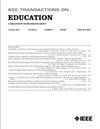Are Educational Escape Rooms More Effective Than Traditional Lectures for Teaching Software Engineering? A Randomized Controlled Trial
IF 2
2区 工程技术
Q2 EDUCATION, SCIENTIFIC DISCIPLINES
引用次数: 0
Abstract
Contribution: This article analyzes the learning effectiveness of a virtual educational escape room for teaching software engineering and compares this activity with traditional teaching through a randomized controlled trial. Background: Educational escape rooms have been used across a wide variety of disciplines at all levels of education and they are becoming increasingly popular among teachers. Nevertheless, there is a clear general need for more robust empirical evidence on the learning effectiveness of these novel activities and, particularly, on their application in software engineering education. Research Questions: Is game-based learning using educational escape rooms more effective than traditional lectures for teaching software engineering? What are the perceptions of software engineering students toward game-based learning using educational escape rooms? Methodology: The study presented in this article is a randomized controlled trial with a pre- and post-test design that was completed by a total of 326 software engineering students. The 164 students belonging to the experimental group learned software modeling by playing an educational escape room whereas the 162 students belonging to the control group learned the same subject matter through a traditional lecture. Findings: The results of the randomized controlled trial show that the students who learned software modeling through the educational escape room had very positive perceptions toward this activity, significantly increased their knowledge, and outperformed those students who learned through a traditional lecture in terms of knowledge acquisition.在软件工程教学中,教育性密室逃脱比传统讲座更有效吗?随机对照试验
贡献:本文通过随机对照试验,分析了虚拟教育逃生室在软件工程教学中的学习效果,并将这一活动与传统教学进行了比较。背景:教育逃生室已被广泛应用于各级教育的各个学科,而且越来越受到教师的欢迎。然而,对于这些新颖活动的学习效果,尤其是它们在软件工程教育中的应用,显然普遍需要更有力的实证证据。研究问题在软件工程教学中,使用教育逃生室进行基于游戏的学习是否比传统授课更有效?软件工程专业学生对利用教育逃生室进行游戏式学习的看法如何?研究方法:本文介绍的研究是一项随机对照试验,采用前测和后测设计,共有 326 名软件工程专业的学生完成了试验。实验组的 164 名学生通过玩教育逃生室来学习软件建模,而对照组的 162 名学生则通过传统的讲座来学习相同的内容。研究结果随机对照试验的结果表明,通过教育逃生室学习软件建模的学生对这一活动有非常积极的看法,他们的知识显著增加,在知识获取方面优于通过传统讲座学习的学生。
本文章由计算机程序翻译,如有差异,请以英文原文为准。
求助全文
约1分钟内获得全文
求助全文
来源期刊

IEEE Transactions on Education
工程技术-工程:电子与电气
CiteScore
5.80
自引率
7.70%
发文量
90
审稿时长
1 months
期刊介绍:
The IEEE Transactions on Education (ToE) publishes significant and original scholarly contributions to education in electrical and electronics engineering, computer engineering, computer science, and other fields within the scope of interest of IEEE. Contributions must address discovery, integration, and/or application of knowledge in education in these fields. Articles must support contributions and assertions with compelling evidence and provide explicit, transparent descriptions of the processes through which the evidence is collected, analyzed, and interpreted. While characteristics of compelling evidence cannot be described to address every conceivable situation, generally assessment of the work being reported must go beyond student self-report and attitudinal data.
 求助内容:
求助内容: 应助结果提醒方式:
应助结果提醒方式:


